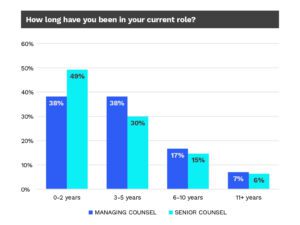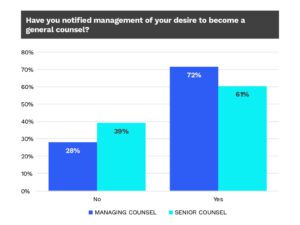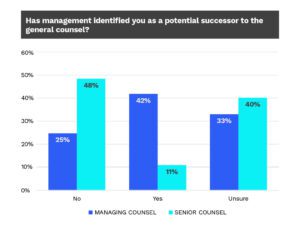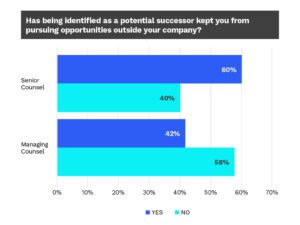How Aspiring GCs Are Mapping A Career Path to General Counsel

By Steve Bell
April 30, 2024

Steve Bell is a Managing Director at BarkerGilmore and Chair of the Industrial and Manufacturing Search Practice. He specializes in identifying and recruiting senior legal and compliance executives. Bell assesses talent not only from a skills perspective, but measures cultural fit, judgment, and what is not on the resume. He can be reached at sbell@barkergilmore.com.
Published in Today’s General Counsel, April/May 2024
The career path to general counsel can be bewildering for in-house legal professionals who aspire to achieve this coveted role. There is no one singular route to GC, and many individuals are actively pursuing the position in unique ways.
In the 2024 Aspiring General Counsel Report, BarkerGilmore analyzed data from senior counsel and managing counsel (including regional GCs, assistant GCs, division GCs, associate GCs, and deputy GCs) nationwide who hope to achieve the GC role and, for some, who have been identified as a GC successor.
Critical Characteristics of Aspiring GCs
An aspiring GC within this context typically refers to legal professionals who hope to work their way up and attain the position of general counsel. These individuals are likely to be currently employed as in-house counsel, with a significant portion having held their current roles for two years or less (38% of managing counsel, 49% of senior counsel).
Aspiring GCs are actively working toward advancing their careers, gaining experience, and acquiring the necessary skills and expertise to eventually assume the responsibilities of a general counsel, which often include overseeing all legal matters within the organization, providing strategic legal advice, managing legal risks, and representing the organization in legal proceedings. The modern general counsel is business-focused and can view certain risks as an opportunity; developing relationships with the business, stakeholders, and senior leadership is pertinent to earning the reputation and skills needed to run a legal program.
The ways senior counsel and managing counsel secured their current positions show the importance of networking and strategic career moves. Senior counsel were most likely to find their current role through a job posting (38%), but managing counsel were recruited directly (22%), contacted by a friend or colleague (21%), or contacted by an executive recruiter (20%).
Managing counsel tend to exhibit a proactive stance in expressing their interest in ascending to the GC role, with a higher percentage informing management of their aspirations than senior counsel (72% of managing partners vs. 61% of senior counsel).
Among the identified successors surveyed, the vast majority (58%) hold the title of deputy general counsel. In a distant second place, just 12% of identified successors hold the title of associate general counsel. It’s only logical that the next step for managing counsel and senior counsel is to pursue the role of deputy general counsel as a stepping stone to general counsel. This is when strong internal relationships become influential, and if growth is unavailable, the opportunity to consider a strategic professional move is the most advantageous risk an aspiring GC can make.
Professional Development
Professional development is a common denominator among aspiring GCs, with most engaging in executive coaching. Thirty-seven percent of managing counsel and 20% of senior counsel have worked with an executive coach in their current position. The coach was likely to be an external service provider for managing counsel (91%) and senior counsel (74%). Managing counsel (71%) and senior counsel (73%) found the coaching valuable or extremely valuable.
Outside of executive coaching, management-identified successors receive professional development at higher rates overall. The top four types of professional development for all groups were expanded scope of responsibility, increased board exposure, leadership training, and stretch assignments.
For those seeking the GC role but have yet to identify as a successor, it is worth speaking with a manager about taking on more responsibilities and stretch assignments to highlight the skills needed to be a GC. Becoming known to the business and executives as an optimistic, energetic team player is the most important proactive step one can take on their own.
Management Identification
The critical role of management identification in the GC succession process is evident, with a substantial percentage of managing counsel (42%) and a noteworthy but smaller fraction of senior counsel (11%) identified as potential successors by leadership.
Executive coaching is a pivotal factor, contributing to a higher likelihood of being recognized as a successor. In-house counsel who have received executive coaching (35%) are more likely to be identified as a successor than their counterparts without executive coaching (26%). Those who have received executive coaching tend to be more visible to management as potential leaders.
Women are more likely than men to be identified as GC successors (53% vs. 47%). This is especially true at non-profits (60% women vs. 40% male) and private companies (59% women vs. 41% male) and in the consumer (75%), industrial/manufacturing (60%), and financial industries (56%).
However, as was uncovered in BarkerGilmore’s 2023 General Counsel Succession Report, women were more likely than men to find out about their successor status a year or less before moving into the new position (66% vs. 53%).
GC Pipeline Lacks Racial Diversity
Despite recent strides toward diversity and inclusion, underrepresented minority groups, including Black, Hispanic, and Indigenous individuals, continue to be significantly underrepresented in high-ranking roles such as associate general counsel, deputy general counsel, successors, and chief legal officers. This underrepresentation of minorities in legal leadership roles stems from various factors ranging from implicit bias in hiring, to lack of access to networking and talent opportunities (both for the hiring company and candidate), to lack of succession planning and employee development.
Among the identified GC successors surveyed, 77% identify as white or Caucasian. Of the remaining sample, 10% identify as Asian or Asian American, 7% identify as Black or African American and 5% identify as Hispanic or Latino.
Addressing racial disparities in legal positions requires concerted efforts to dismantle systemic barriers and promote equity within the legal profession. This includes implementing diversity initiatives, reforming hiring and promotion practices, providing mentorship and professional development opportunities, and fostering a culture of inclusion within legal organizations and networking groups.
BarkerGilmore is focused on DEI and the representation of women and underrepresented minority groups and is proud to help facilitate the conversation surrounding best hiring practices and how to develop the next generation of modern general counsel. Over the last three years, 72% of our placements have been a woman or underrepresented minority, and we look forward to continuing this trend.
Charting a Course to GC
In navigating a career path to general counsel, legal professionals are encouraged to embrace a multifaceted approach, combining proactive communication with management, strategic networking, and a commitment to continuous professional development.
Critical intelligence for general counsel
Stay on top of the latest news, solutions and best practices by reading Daily Updates from Today's General Counsel.
Daily Updates
Sign up for our free daily newsletter for the latest news and business legal developments.








